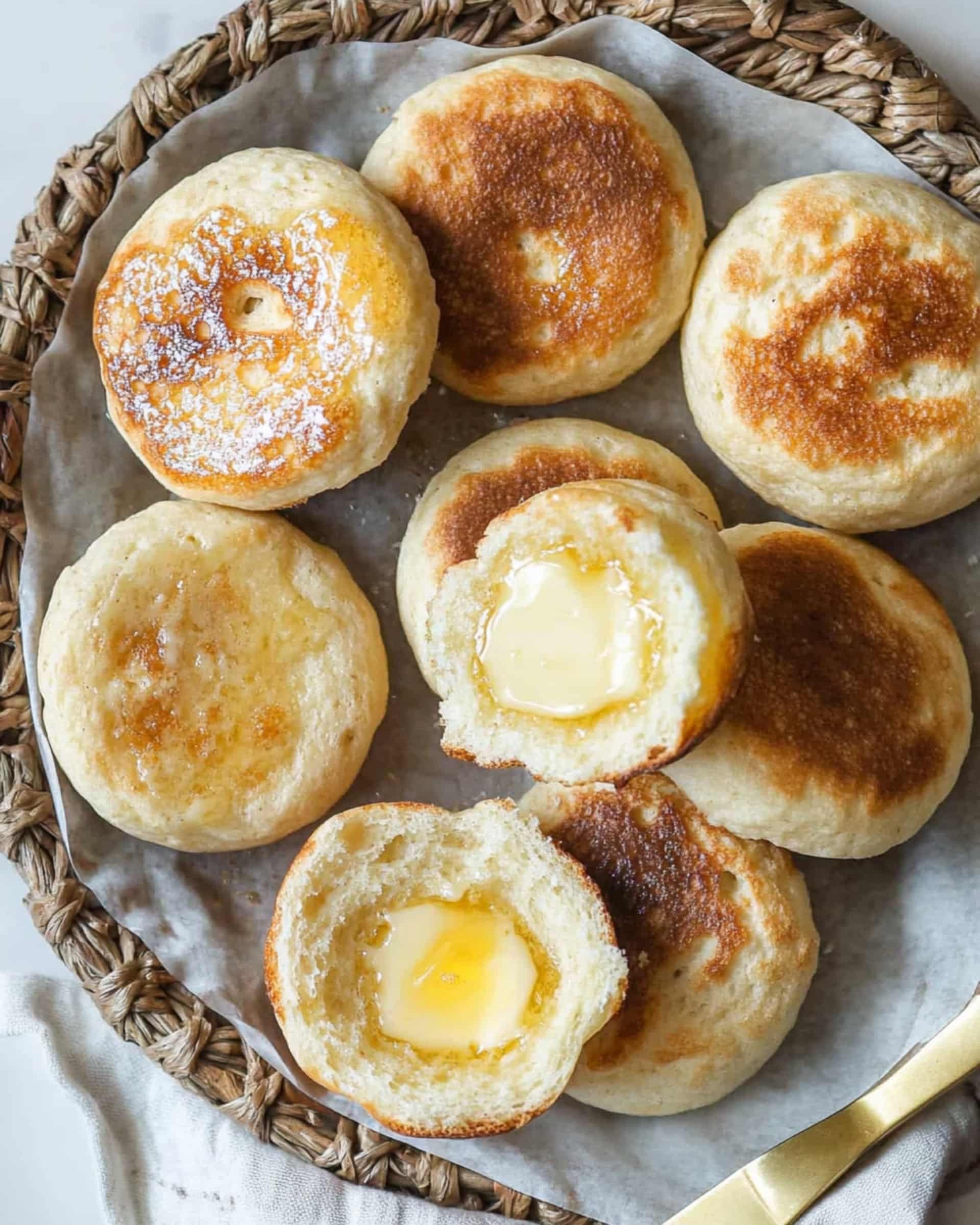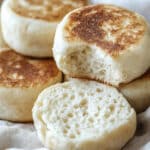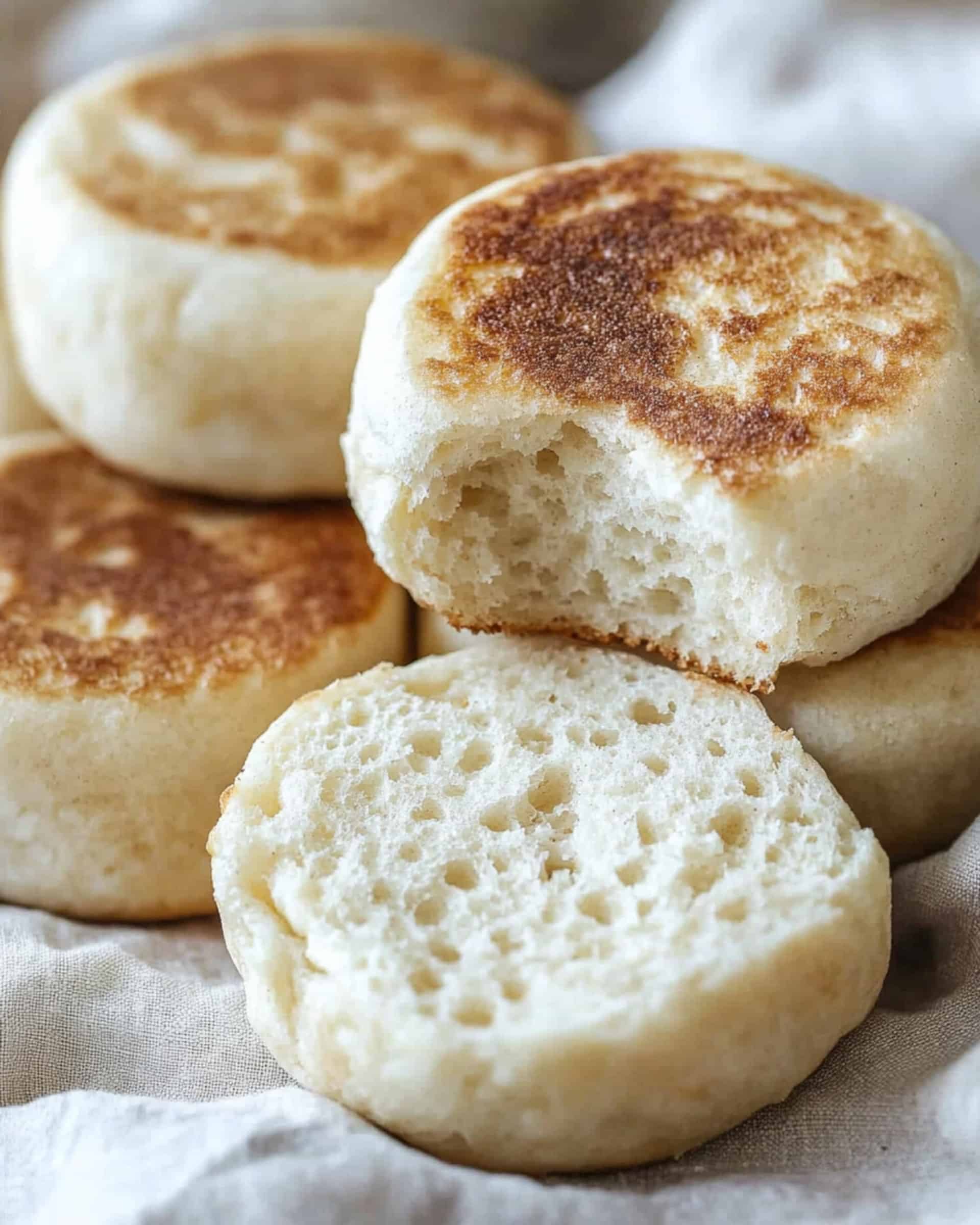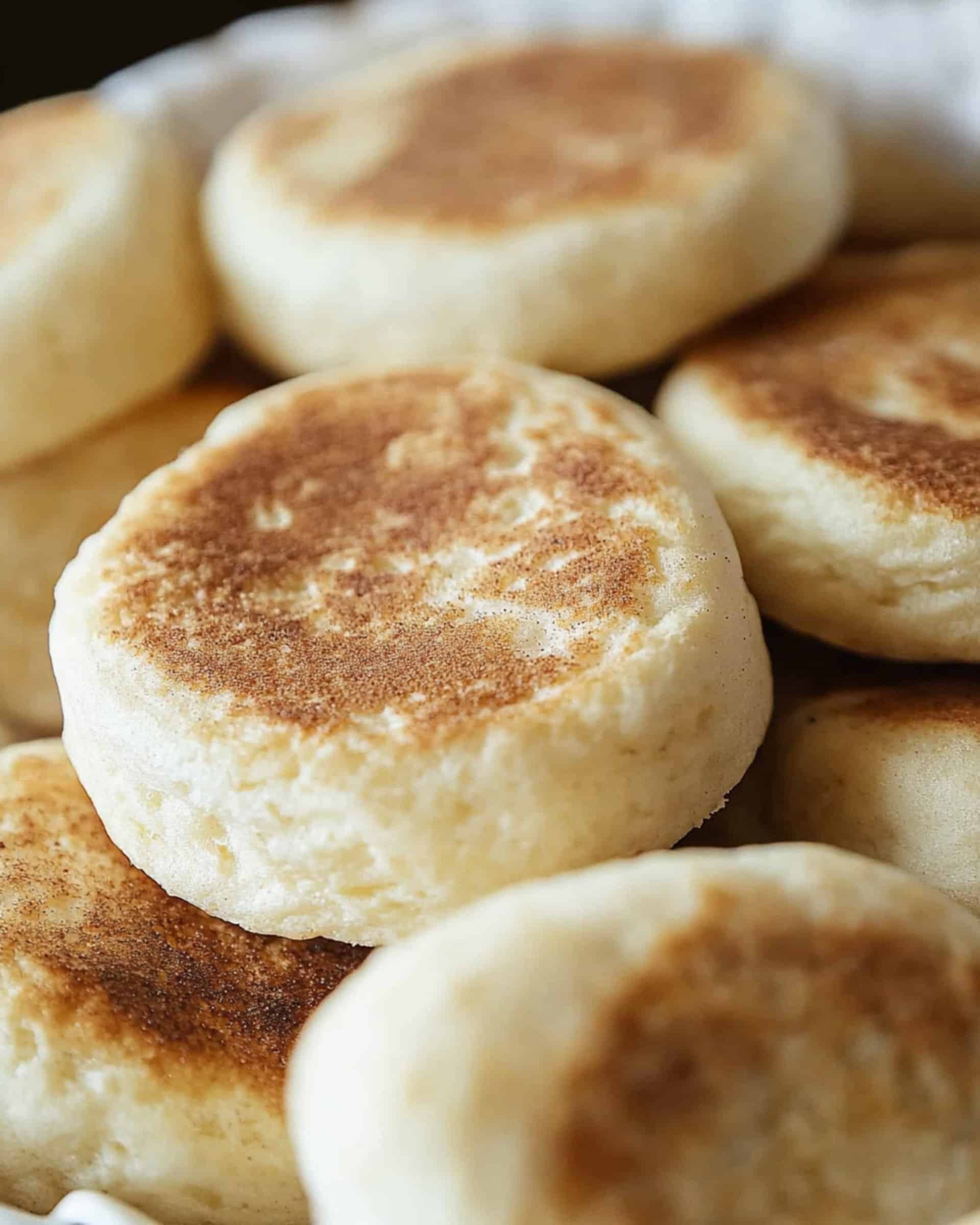These homemade Sourdough Discard English Muffins are a game-changer for breakfast lovers! Delightfully chewy with those classic nooks and crannies we all crave, these English muffins transform your extra sourdough discard into something truly spectacular. The slight tang from the discard pairs perfectly with the subtle sweetness, creating a breakfast treat that’s miles better than anything store-bought.
Why You’ll Love This Recipe
- Uses Up Discard: Finally, a delicious purpose for that sourdough discard you’ve been accumulating! No more waste, just delicious results.
- Easier Than You Think: Despite their artisanal look, these English muffins are surprisingly straightforward to make, requiring basic ingredients and simple techniques.
- Customizable: Make them thicker for a hearty breakfast sandwich base or thinner for a lighter option – either way, they’re incredible.
- Better Than Store-Bought: The texture and flavor of homemade English muffins will make you wonder why you ever purchased the packaged kind.
Ingredients You’ll Need
- Whole Milk: Provides richness and helps create that tender interior. The proteins in milk also contribute to a beautiful golden crust.
- Unsalted Butter: Adds richness and helps create that characteristic English muffin texture. The fat contributes to both flavor and keeping qualities.
- Brown Sugar: Provides food for the yeast and contributes a subtle caramel note that white sugar just doesn’t match.
- Active Dry Yeast: Works with your sourdough discard for proper rising. The combination gives you the best of both worlds – convenience and flavor.
- Sourdough Discard: The star ingredient! Brings tangy flavor and contributes to the fantastic texture with those signature nooks and crannies.
- Bread Flour: Higher protein content means better structure and chewiness – exactly what we want in an English muffin.
- Kosher Salt: Balances the flavor and controls yeast activity. Don’t skip it!
- Cornmeal or Semolina Flour: Not technically in the dough, but essential for that authentic English muffin exterior and preventing sticking.
Variations
Want to mix things up? Here are some delicious ways to customize your sourdough English muffins:
- Whole Grain Version: Replace up to half the bread flour with whole wheat flour for extra nutrition and nutty flavor.
- Cinnamon Raisin: Add 1 tablespoon of cinnamon and 3/4 cup of raisins to the dough for a sweet breakfast treat.
- Herb & Cheese: Fold in 1/2 cup of shredded cheese (cheddar works beautifully) and 1 tablespoon of dried herbs like rosemary or thyme.
- Everything Bagel: Sprinkle everything bagel seasoning on top of the muffins before the final rise.
How to Make Sourdough Discard English Muffins
Step 1: Mix the Wet Ingredients
In a large mixing bowl, combine warm milk (110°F), melted butter, brown sugar, active dry yeast, and sourdough discard. Let this mixture sit for a few minutes to activate the yeast – you’ll know it’s working when it looks slightly foamy.
Step 2: Add Dry Ingredients
Add the bread flour and salt to your wet ingredients and mix with a dough whisk or wooden spoon until you have a slightly sticky dough. All ingredients should be thoroughly combined, but don’t overmix.
Step 3: First Rise
Cover the bowl with a clean kitchen towel or plastic wrap and let the dough rise until it’s doubled in size, which typically takes 60-90 minutes in a warm kitchen.
Step 4: Optional Overnight Chill
For enhanced flavor, refrigerate the dough overnight. This slow fermentation develops complex flavors and improves texture. If you’re in a hurry, you can skip this step, but I highly recommend it if you have the time.
Step 5: Shape the Muffins
Turn the dough out onto a lightly floured surface and roll or press it to about 1-inch thickness. Cut rounds using a biscuit cutter or drinking glass. Reshape any scraps by stacking them, re-rolling, and cutting again until all dough is used.
Step 6: Second Rise
Place your shaped muffins on a baking sheet generously dusted with cornmeal or semolina flour. Make sure both sides get well-coated. Cover them and let rise for about an hour (or two if coming from the refrigerator) until they’re noticeably puffy.
Step 7: Cook the Muffins
Preheat an electric skillet to 300°F or a heavy skillet over medium-low heat. Cook the muffins covered for 5 minutes on each side. For thicker muffins, reduce heat to 250°F and flip occasionally until the internal temperature reaches 195-200°F. Alternatively, finish them in a 350°F oven for about 10 minutes.
Step 8: Cool and Serve
Transfer the cooked muffins to a cooling rack and allow them to cool completely. For the perfect nooks and crannies, split them with a fork rather than cutting with a knife.
Pro Tips for Making the Recipe
- Temperature Matters: Use a thermometer to make sure your milk is around 110°F – too hot will kill the yeast, too cold won’t activate it properly.
- Don’t Skip the Cornmeal: That distinctive coating isn’t just for looks – it prevents sticking and adds authentic texture and flavor.
- Be Patient With Rising: Properly risen dough makes all the difference between dense muffins and those with beautiful air pockets.
- Fork Split, Don’t Knife Cut: For those classic nooks and crannies, always split your English muffins with a fork by inserting it around the edges and gently pulling apart.
- Watch Your Heat: Too hot and they’ll burn before cooking through; too cool and they won’t develop that perfect crust. Adjust as needed based on your stove.
How to Serve

These sourdough English muffins shine in so many ways:
Classic Breakfast:
Toast until golden and top with butter and jam or honey for the perfect breakfast accompaniment to eggs and coffee.
Breakfast Sandwiches:
Create the ultimate breakfast sandwich with a fried egg, cheese, and bacon or avocado.
Eggs Benedict Base:
These make an exceptional foundation for homemade eggs Benedict – the nooks and crannies catch all that hollandaise sauce perfectly.
Mini Pizzas:
Split, toast lightly, top with sauce, cheese, and toppings, then broil for quick personal pizzas that kids and adults love.
Make Ahead and Storage
Storing Leftovers
Store cooled English muffins in an airtight container or bag at room temperature for up to 3 days, or refrigerate for up to a week.
Freezing
These freeze beautifully! Place cooled muffins in a freezer bag with parchment between layers to prevent sticking. Freeze for up to 3 months.
Reheating
For the best texture, thaw frozen muffins at room temperature, then toast. For fresh muffins, simply split with a fork and toast until golden brown. The toasting really brings out their flavor and creates that perfect crispy exterior.
FAQs
Can I use all-purpose flour instead of bread flour?
Yes, you can substitute all-purpose flour, though your muffins might be slightly less chewy. The texture will still be good, but bread flour gives that ideal English muffin bite.
My dough seems too sticky. Should I add more flour?
This dough should be slightly sticky. Instead of adding more flour, use well-floured hands when handling it. Too much additional flour can make your muffins dense, so resist the urge to add a lot more unless absolutely necessary.
Can I make these without sourdough discard?
While you could replace the discard with additional flour and liquid, you’d miss out on the distinctive tangy flavor that makes these special. If you don’t have sourdough starter, consider making regular English muffins instead.
Why aren’t my English muffins getting those classic nooks and crannies?
Two likely culprits: either your dough didn’t rise enough before cooking, or you cut them with a knife instead of splitting with a fork. The fork-splitting method creates those irregular surfaces that toast up so beautifully.
Final Thoughts
These Sourdough Discard English Muffins are truly worth every minute spent making them. There’s something deeply satisfying about transforming your sourdough discard into these golden, perfectly textured breakfast treats. Whether slathered with butter and jam or holding together your favorite breakfast sandwich, they’ll elevate your morning routine. The first time you split one open to reveal those perfect nooks and crannies, you’ll be hooked for life!
Print
Sourdough Discard English Muffins Recipe
- Prep Time: 30 minutes
- Cook Time: 20 minutes
- Total Time: 2.5 hours plus optional chilling
- Yield: 8–12 English Muffins 1x
- Category: Bread
- Method: Frying
- Cuisine: American
- Diet: Vegetarian
Description
Sourdough Discard English Muffins are a delightful way to use up sourdough discard and enjoy fluffy, tender muffins with perfect nooks and crannies. This recipe offers a great balance of flavor and texture, with an option to customize thickness and shape to your preference.
Ingredients
For the Dough
-
- 1 cup whole milk (240 grams), warmed to 110 degrees F
- 2 tablespoons (28 grams or 1 ounce) unsalted butter, melted
- 2 tablespoons (30 grams) brown sugar (or sweetener of choice)
- 1 teaspoon (3 grams) active dry yeast
- 1/2 cup (140 grams) sourdough discard
- 2 1/2 cups (300 grams) bread flour
- 2 teaspoons (6 grams) kosher salt*
For Cooking
- Cornmeal or semolina flour (for dusting)
Instructions
- Mix Ingredients: Mix warm milk, melted butter, sourdough discard, sugar, and yeast in a large mixing bowl and let sit for a few minutes. Next, add flour and salt and mix with a dough whisk or wooden spoon until a slightly sticky dough forms and all ingredients are thoroughly combined.
- Let Dough Rise: Cover the bowl and let the dough rise until doubled in size, which should take 60-90 minutes. For added flavor, consider refrigerating the dough overnight at this stage (optional).
- Prepare Dough for Shaping: After the dough has doubled in size (or after chilling), dump it onto a floured surface and press or roll out to about a 1-inch thickness. Use a biscuit cutter or a drinking glass/jar to cut rounds. Reshape scraps by stacking them, re-rolling, and cutting. Adjust thickness based on desired muffin size; the recipe typically yields 9-10 muffins, depending on thickness.
- Shape Muffins: Place the shaped muffins on a pan lined heavily with cornmeal or semolina flour, and dust both sides well. Cover the muffins and let them rise for about an hour until they are puffy and light. If the dough was chilled, the rise time may take about 2 hours.
- Cook Muffins: Preheat an electric skillet to 300°F or a heavy skillet over medium-low heat. Place the risen muffins in the skillet, leaving some space between each one. Cover and cook for 5 minutes. Flip the muffins and cook for another 5 minutes, covered. Reduce the heat to about 250°F if needed, and flip the muffins a few more times until their internal temperature registers 195-200°F. Alternatively, finish cooking them in a 350°F oven for about 10 minutes, depending on the thickness.
- Cool and Serve: Remove muffins to a cooling rack and allow them to cool to room temperature. For the best craggy nooks and crannies, use a fork and your fingers to pry the halves apart before toasting and serving.
- Alternative Shaping Option: Instead of rolling and cutting rounds, divide the dough into 8-12 pieces. Shape each piece into a ball, then press the ball flat into a disk. This method minimizes scraps and simplifies preparation.
Notes
- For extra flavor, refrigerate dough overnight after the first rise for a richer tang.
- For thinner muffins, roll the dough out thinner before shaping, which will also yield more muffins.
- If finishing in the oven, adjust the cooking time based on your muffin thickness.
- Dust muffins generously with cornmeal or semolina flour to prevent sticking during cooking.
- For classic nooks and crannies, avoid cutting muffins with a knife and instead use a fork to split them.
Nutrition
- Serving Size: 1 muffin
- Calories: 180
- Sugar: 3g
- Sodium: 200mg
- Fat: 4g
- Saturated Fat: 2.5g
- Unsaturated Fat: 1.5g
- Trans Fat: 0g
- Carbohydrates: 30g
- Fiber: 1g
- Protein: 5g
- Cholesterol: 10mg



